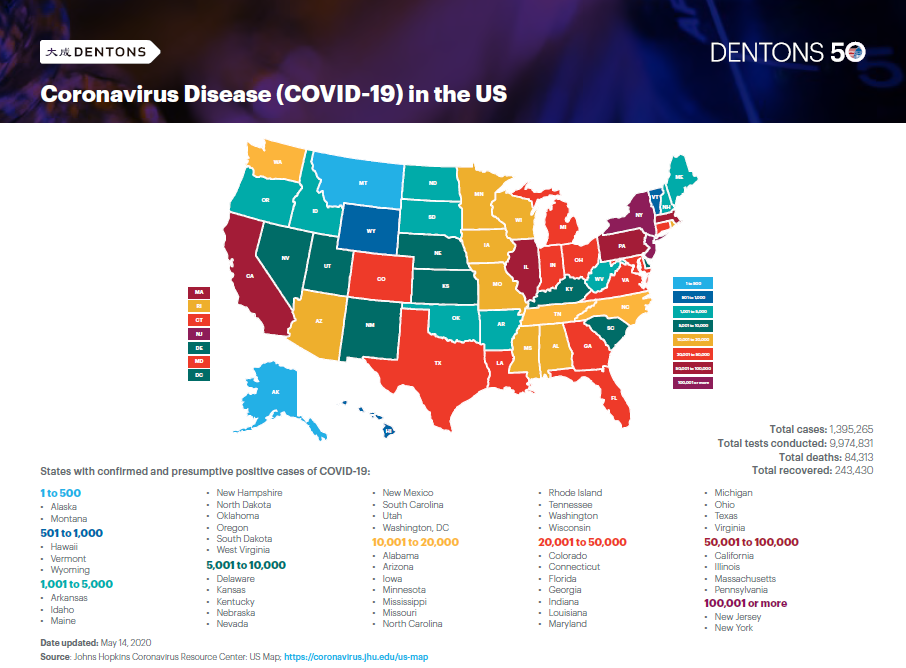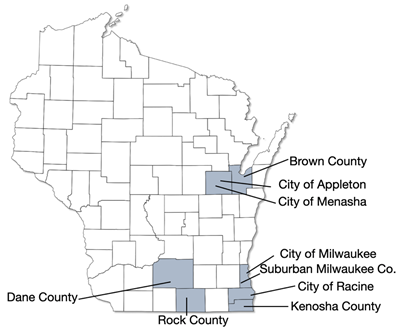
Connecticut
As of May 13th
Governor Lamont signs 40th executive order to mitigate the spread of COVID-19
Yesterday, Governor Lamont signed another executive order – the 40th since he enacted the emergency declarations. Executive Order No. 7MM enacts the following provisions:
- Allows municipalities to expedite changes to their zoning rules or other ordinances to expand outdoor dining
- Creates an expedited approval process for restaurants and other establishments that serve food to get fast-tracked permission to create or expand outdoor dining areas
- Allows other businesses such as retail stores to get fast-tracked permission to sell goods on the sidewalk or in other outdoor areas, including shared spaces or spaces provided by municipalities
- Allows restaurants and other businesses who already have liquor permits to serve alcohol only with food without applying for a separate patio or extension of use permit
- Allows private clubs to sell alcohol only to their members for delivery or pickup
- NOTE: A separate executive order will provide for the Phase I reopening of businesses and other activity, including those that are subject to yesterday’s order. All of the Phase I reopening activity will be subject to operating rules issued by the Department of Economic and Community Development.
Data updates on COVID-19 testing in Connecticut
The following is a summary of the day-to-day newly reported data on cases, deaths, and tests in Connecticut.
| Overall Summary | Statewide Total | Change Since Yesterday |
| Laboratory-Confirmed COVID-19 Cases | 34,333 | +568 |
| COVID-19-Associated Deaths | 3,041 | +33 |
| Patients Currently Hospitalized with COVID-19 | 1,189 | -23 |
| COVID-19 Test Reported | 138,424 | +5,916 |
Georgia
As of May 14th
- Daily State Public Health stats [now released 9a, 1p and 7p daily]:
- As of 11:15a today, Georgia has 35,793 confirmed cases as compared to 35,332 at 3:48p Wednesday, with 6,320 hospitalized patients as compared to 6,259 at 3:48p Wednesday, and 1,523 deaths as compared to 1,505 at 3:48p Wednesday. Over 285,000 tests have been administered.
- Per State economist Jeffery Dorfman, GA may spend up to $1.5b from reserve funds by June 30.
- Governor Kemp’s chief management officer will now serve as Dr. Toomey’s chief of staff to run the operations side of DPH.
- The House and Senate Appropriations Committees will hold a joint virtual meeting on May 18 at 3p.
Local:
- Housing sales in 11 metro Atlanta counties were down 25.8% from the same month a year ago.
Minnesota
As of May 14th
Last night, in a livestreamed address, Governor Walz announced the next phase of Minnesota’s fight against the Coronavirus. Minnesota’s current Stay at Home order, first put in place on March 28th, is set to expire at 11:59 pm on Sunday, May 17th. The Governor will allow that order to expire. Replacing his previous order is Executive Peacetime Order 20-56, termed “Stay Safe Minnesota”. The new order goes into effect at 12:00 am, Monday May 18th and will slowly begin to turn the dial and allow more small businesses and retailers to open. Order 20-56 will allow those customer facing retailers who have been providing curb-side service to now allow customers into their businesses, malls and other retailers will also be able to open their doors. The order will require these businesses to have documented and posted plans outlining employee and customer safety. These businesses will be limited to 50% of their Fire Marshal approved capacity and must practice social distancing.
The new order does not allow gyms, salons, bars, restaurants or places of amusement or entertainment to open. Governor Walz has directed his administration to provide guidance to those businesses by May 20th, with hopes of allowing them to start with restricted and limited access on June 1st. Large events and businesses where people gather in close proximity are still canceled or closed. These closings include public pools, common areas in malls, campgrounds and sporting events. The order does allow gatherings in places of worship, but limits those gatherings to no more than 10 individuals. The Governor’s order urges Minnesotans who can, to continue working from home and sheltering in place. The Governor also requests Minnesota residents to stay close to home and limit travel. The Governor’s order does allow for small gatherings of no more than 10 individuals in settings where social distancing must be maintained.
In addition to Executive Order 20-56, Stay Safe Minnesota, Governor Walz signed a number of additional executive orders and had them approved by the state’s Executive Council. The following is a complete list of the new Executive Orders.
- Executive Order 20-53: This order extends the Governor’s Peacetime Emergency Declaration and continues the Governor’s ability to issue Executive Orders through June 12.
- Executive Order 20-54: This order provides new protections for workers from retaliation and unsafe working conditions. The order creates a new level of protection during the COVID crisis for any employee who asks for accommodations to protect their own health.
- Executive Order 20-55: This order focuses on protecting at-risk populations, urges certain groups to stay at home and provides for additional access to services and protections.
- Executive Order 20-56: This order replaces Minnesota’s Stay at Home order as of May 18th, and begins to allow for the opening of Minnesota businesses and other activities.
Governor Walz provided a letter to Legislative Leaders regarding his 30-day extension of Minnesota’s Peacetime Emergency Declaration. In that letter, Governor Walz indicated he will call the Minnesota Legislature back for a Special Session prior to June 12th, if he determines another 30 extension is necessary.
As Minnesota businesses begin the process of opening their doors, I suggest you continue to monitor the Department of Employment and Economic Development website. DEED continues to update their guidance and provides a number of resources for Minnesota employers and employees. The following is a link to their most recent guidance.
MN DEED Guidance on Opening Businesses
Minnesota’s Updated COVID-19 Statistics
| Confirmed Cases | 13,435 (1,600 healthcare workers) |
| Total Deaths confirmed | 663 |
| Nursing Home/Long-term care deaths | 537 |
| Hospitalizations (total) | 1,915 |
| Hospitalizations (current) | 498 |
| ICU Hospitalizations (current) | 203 |
| Completed Tests | 128,752 |
In addition to yesterday’s Executive Orders, the Walz Administration also released the most recent COVID-19 Modeling they have been working on with the University of Minnesota. The modeling suggests the following Minnesota specific results over the next 12 months: range of deaths 16,000 – 44,000, a mean of deaths totaling 29,000 and a shocking 1,400 additional deaths by the end of the month. The peak is projected to take place on July 6th. The modeling also predicted a continuation of the current Stay and Shelter order through the end of the month would have little impact on the total number of deaths. The new model used the most recent data available to the University, two impacts on the modeling are related to Minnesota’s effectiveness of social distancing which has fallen to 38% from the originally predicted 50%, and the Stay at Home Order effectiveness which is now at 59.5% down from the original 80%.
As we approach May 18th and June 1st – there will likely be more questions than answers on how to proceed, please use us as a resource for helping to find answers to your specific questions.
New York
As of May 13th
Hospitals:
- Elective surgeries to continue in 12 more counties
- Albany, Cayuga, Chemung, Columbia, Clinton, Cortland, Montgomery, Orange, Otsego, Renselaer, Schenectady, Warren
Reopening:
- Finger Lakes, Mohawk Valley, North County, and Southern Tier meet metrics for reopening
- The governor reiterated Dr. Faucci’s warning about reopening too soon
- Calibrate/control by monitoring diagnostic testing, antibody testing, hospitalizations rate and capacity, infection rate
- Regional control group should manage, monitor, and ensure compliance with safety precautions
- We must stay alert because we are still learning
Children and COVID-19:
- DOH is investigating 102 cases of what may be rare COVID- related illness in children with symptoms similar to Kawasaki disease or toxic shock like syndrome
- Illness has taken lives of 5 year old boy, 7 year old boy, and 18 year old girl
- 60% of children with symptoms tested positive for COVID-19 and 40% tested positive for the antibodies (14% positive for both). 71% of cases end up in ICU.
- On Monday, DOH sent alert to 49 other state health departments and Dr. Zucker did nationwide call with health commissioner as part of NY’s role as leading national effort on new syndrome
- 14 other states (California, Connecticut, Delaware, Georgia, Illinois, Kentucky, Louisiana, Massachusetts, Mississippi, New Jersey, Ohio, Pennsylvania, Utah, Washington) Washington D.C, and Spain, France, England, Italy, and Switzerland have reported cases as well
- Parents who have been exposed to COVID-19 or have reason to believe their child has been exposed should take heightened precautions and seek medical attention
- Hospitals have been directed by DOH to prioritize COVID-19 testing for children presenting symptoms
Federal Assistance:
- New York has a significant funding gap of $61B
- Funding is necessary for essential workers, state testing and tracing, public infrastructures as economic stimulus
SALT Repeal
- Costs $29B to NY
- No corporate giveaways for layoffs
- Governor Washington Op-Ed: “Make sure subsidies are tied to worker protections.”
- Americans First Law: No corporate bailout if workers will be laid off
- Will be introduced by congressional delegation
Texas
As of May 14th
The Governor of the State of Texas has issued a Proclamation renewing disaster proclamation for all counties in Texas.
This information is provided by Dentons powered by Libryo. Sign up for free access to the COVID-19 Regulation Tracker here.
Virginia
As of May 13th
Total cases: 26,746
Hospitalizations: 3,520
Deaths: 927
The latest:
- Non-essential businesses will be permitted to reopen across Virginia – but not in Northern Virginia – on a limited basis starting Friday, May 15.
- The first phase of opening will last at least two weeks, and beaches will remain closed, except for fishing and exercising.
- In Northern Virginia localities, non-essential businesses will remain closed for at least two more weeks.
Gov. Ralph Northam said Wednesday that the state will move forward with conditions that allow many non-essential businesses to reopen on Friday, May 15, but not in localities in Northern Virginia, where the outbreak has been more pronounced.
Elsewhere in Virginia, non-essential retail businesses and churches will be permitted to reopen at 50 percent of indoor capacity. Personal grooming businesses such as salons and barbershops will be able to serve customers by appointment only, and so long as staff and customers wear face masks, the governor said.
Wearing face masks, teleworking and practicing social distancing will remain recommended practices. Restaurants will be permitted to serve customers at half the outdoor seating capacity; indoor dining will remain prohibited. Beaches will be open for fishing and exercising only. Entertainment and amusement venues, as well as overnight summer camps, will remain closed. Public gatherings of more than 10 people will continue to be banned.
Northam said this phase of reopening will last a minimum of two weeks, and officials will evaluate public health data before determining whether sufficient progress has been made to warrant further relaxing restrictions.
Data from Johns Hopkins University showed Virginia ranked No. 48 in the US in terms of testing rates, but Northam has said the state is increasing its testing capabilities. Those increased tests have revealed a decline in the percentage of positive cases in recent days. Virginia continues to restock its supplies of personal protective equipment, and hospital bed occupancies have remained stable. Hospitals, healthcare systems and medical and dental offices were allowed to resume outpatient, elective and non-emergency procedures on May 1.
The current restrictions on non-essential businesses, including restaurants and indoor recreation and entertainment businesses, will remain in effect in Northern Virginia, where local leaders requested the governor maintain tight restrictions. The state’s stay-at-home order, in effect until June 10, is being amended to inform Virginians that they are safer at home, Northam said. He encouraged older Virginians and others at higher risk of developing complications associated with infection to remain home as the state begins to reopen.
Public schools remain closed for the rest of the academic year. Municipal elections scheduled for May 5 were already rescheduled to May 19, and congressional primaries from June 9 to June 23.
Initial unemployment claims have begun to recede but remain historically high. According to the Virginia Employment Commission, more than 376,000 continued week unemployment claims had been filed in the week ending May 2. The figure amounts to more than 10 percent of the private-sector payroll in Virginia.
Wisconsin
As of May 14th
Counties that have adopted “Safer-At-Home” extension
Following the Wisconsin Supreme Court’s 4-3 decision that declared that Emergency Order #28 (EO #28) is “unlawful, invalid and unenforceable,” several Wisconsin counties and municipalities have utilized their local authority to issue public health orders that adopt the provisions of EO #28 as well as the provisions contained in Emergency Orders #34 and #36 (the “Turn the Dial” orders that allowed for curbside pickup for retail and opening smaller retail operations to up to 5 patrons).
Those local authority orders tied to EO#28 remain in effect until 8:00 AM on Tuesday, May 26th. The City of Appleton’s order is in effect until May 20th. The city of Milwaukee and city of Menasha have orders with no expiration date and remain in effect until a superseding order is issued.

- City of Appleton: City of Appleton Health Order
- Dane County: Public Health Madison & Dane County order
- Brown County: Order of the Brown County Health Officer
- Kenosha County: Order of the Kenosha County Health Officer
- City of Menasha: City of Menasha Safer at Home Order
- City of Milwaukee: Milwaukee Commissioner of Health Order
- Suburban Milwaukee County: COVID-19 Public Health Plan for Suburban Milwaukee County
- City of Racine: Order of the City of Racine Public Health Department
- Rock County: Order of the Rock County Public Health Department
We will update if additional orders are issued in this afternoon’s update.
Other counties are encouraging businesses that choose to open their doors to follow the CDC guidelines and to consider using the guidelines provided by the Wisconsin Economic Development Corporation.
Waukesha County:
Waukesha County Executive Paul Farrow made the following statement after the Wisconsin Supreme Court strikes down the “Safer at Home” order extension on May 13, 2020.
“The health and safety of the public is my top priority. We have already seen essential businesses take extraordinary steps to continue to provide service while keeping their employees and members of the public safe, and there’s no reason why other businesses can’t do the same.
“In light of the Wisconsin Supreme Court ruling, many businesses that have been closed will choose to open their doors tomorrow, and many others will choose to expand their operations. We trust our businesses will do so responsibly. All Waukesha County businesses should continue to follow CDC guidelines for social distancing and cleaning and disinfecting whenever possible. They should also consider the guidelines provided by the Wisconsin Economic Development Corporation and consult with their respective trade or business organizations to identify industry best practices to safely welcome back employees and customers.
“Waukesha County continues to have an active and aggressive response to the COVID-19 pandemic.
The County’s Public Health Division, Emergency Operations Center, and other departments and divisions are working to keep residents as safe as possible while allowing our economy to recover from the effects of COVID-19.
Link to entire release
Eau Claire County:
The following statement was issue by Lieske Giese, Director of the Eau Claire City-County Health Department:
“In the wake of the Wisconsin Supreme Court ruling regarding the Safer-At-Home order, the Eau Claire City-County Health Department is consulting with state and local authorities about possible next steps. In the meantime, in the interests of preventing spread of COVID-19, we respectfully request that Eau Claire County residents voluntarily continue to follow safe social distancing practices.”
Link to release

